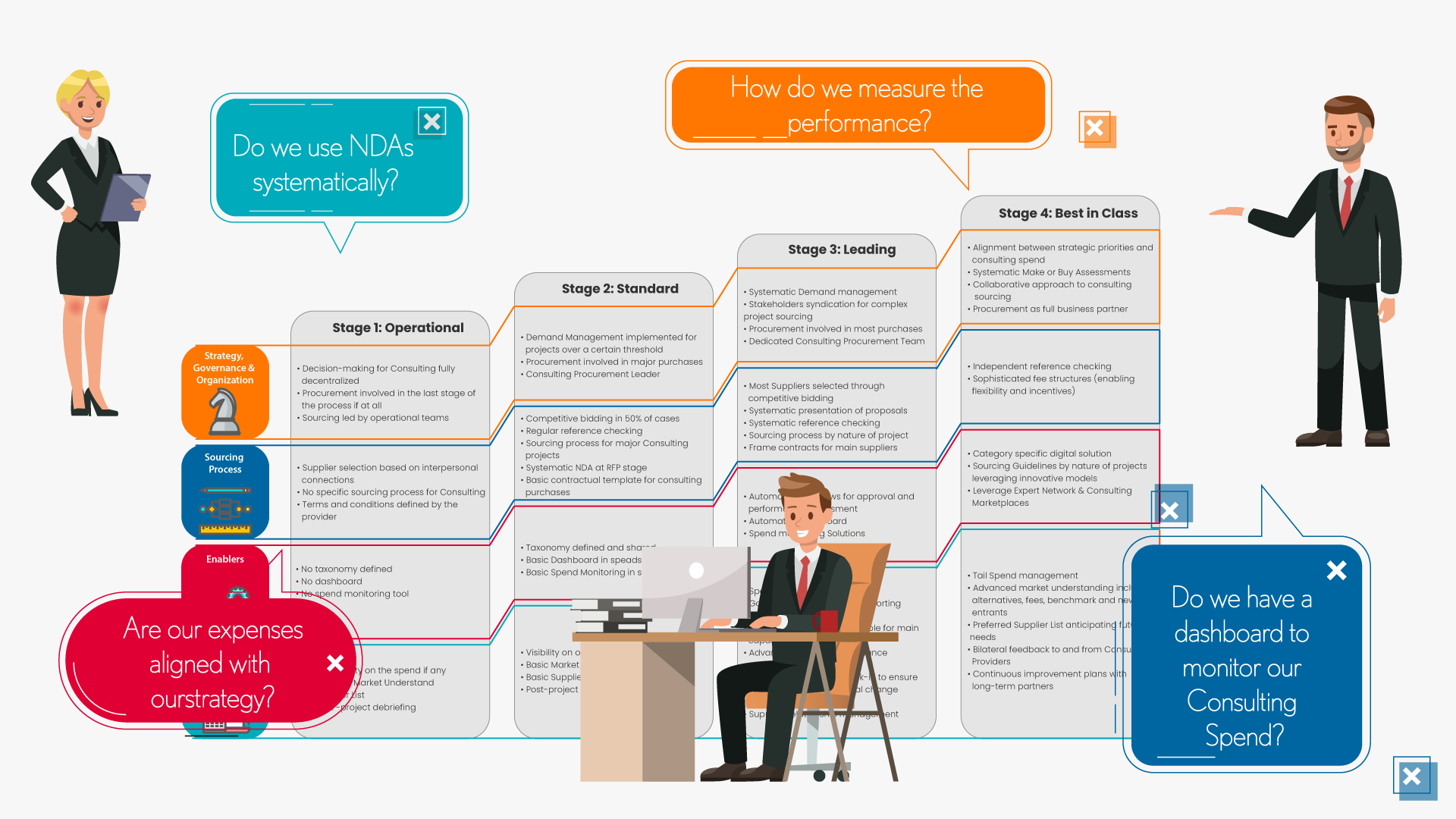Table des matières
Every organization wants better outcomes from consulting—but most struggle to define what “better” even looks like. Is it cost control? Faster delivery? Better partners? The truth is, achieving consulting excellence isn’t a matter of luck or intuition. It’s about capability—and capabilities can be measured.
That’s where maturity models come in.
Maturity grids are tools designed to help organizations understand how structured, consistent, and effective their processes truly are. Think of them as a mirror that reflects both your strengths and your blind spots. In consulting procurement, where decisions can influence millions in spend and the trajectory of key transformations, that mirror is especially important.
At Consulting Quest, we’ve been helping clients benchmark and elevate their consulting sourcing capabilities for years. But the environment has evolved. Expectations are higher, consulting delivery models are more complex, and procurement teams are playing a more strategic role.
That’s why we’ve refreshed the Grille de maturité pour l'acquisition de services de conseil for 2025.
This new version is built for clarity and action. It sharpens the focus on what matters most—how well you Utilize, Buy, et Manage consulting—and how your Gestion de la catégorie, Organisation, et Digital Tools support that effort. It replaces a mixed model with a clean, two-pillar framework: three process dimensions et three enabling ones.

In this article, we’ll walk you through this redesigned grid. You’ll learn how to diagnose your current level, understand what maturity looks like at every stage, and start building the roadmap toward stronger, smarter consulting procurement.
Let’s begin.
What Is a Maturity Grid (And Why It Matters in Consulting Procurement?)
Imagine trying to improve your consulting procurement performance without knowing how well you’re currently doing. It’s like navigating without a map—or worse, using someone else’s map without realizing it. That’s where maturity grids come in.
UN maturity grid (or maturity model) is a structured framework used to evaluate how advanced, consistent, and effective an organization is in a particular area. Think of it as a benchmarking tool that plots your current practices against best-in-class standards.
Each grid typically outlines a set of key dimensions—in our case, the core processes and enablers that drive excellence in consulting procurement. Alongside each dimension, the grid defines levels of maturity, ranging from Novice à Avancée, capturing how an organization evolves as it gains capability.
The benefits? Clear visibility into:
- What you’re doing well
- Where you’re falling short
- What the next step in your evolution should be
In short: it transforms improvement from a vague ambition into a concrete, trackable journey.
💡 Why Consulting Procurement Needs a Maturity Framework
Consulting is a unique category—high-value, low-frequency, and highly strategic. Unlike commodities or standardized services, consulting projects often involve multiple stakeholders, abstract deliverables, and high stakes for the business. That makes consistency, governance, and capability absolutely critical.
Yet, in many companies, consulting is still managed with informal rules, outdated templates, or no category strategy at all. The result? Missed opportunities, inflated fees, unmeasurable outcomes, and a general sense that “we could be doing this better.”
A maturity model tailored to consulting procurement:
- Helps you assess the current state of your practices across process and enabler dimensions
- Identifies actionable steps to reach higher levels of performance
- Enables your organization to compare across teams, divisions, or geographies
- Supports la gestion du changement by framing progress in clear, structured terms
It’s not about labeling teams as “good” or “bad.” It’s about equipping them to do better, with clarity and purpose.
🧭 How the Scoring Works
In the updated 2025 maturity grid, each dimension is evaluated across four maturity levels:
- Novice – Ad hoc or informal practices; no systematic approach
- Basic – Some structure in place; inconsistent execution
- Proficient – Standardized and repeatable practices; moderate integration
- Avancée – Strategic, optimized processes with measurable value creation
Each level represents a stepping stone. The assessment is not just a snapshot—it’s a roadmap. Your average score gives you a picture of your maturity today, while the individual scores per dimension show you where to act first.
Why We Updated the Maturity Grid — Making Maturity Actionable
Over the years, the Consulting Procurement Maturity Grid has helped organizations benchmark their sourcing capabilities. But as the landscape of consulting—and procurement itself—continues to evolve, we recognized a critical need: a model that is clearer, more operationally grounded, and better aligned with the way consulting is actually bought and managed inside companies.
So in 2025, we refreshed the model from the ground up. The goal?
To build a tool that not only diagnoses performance gaps, but also educates internal stakeholders and drives real transformation.
Here’s what’s changed—and why it matters.
🔄 What’s New (and Strategic)
The previous maturity model blended strategic, procedural, and enabling topics—informative, but not always actionable.
The new grid introduces two distinct clusters:
- Three core process dimensions that reflect the lifecycle of a consulting engagement
- Three enablers that power and scale that capability across the organization
This structured approach doesn’t just improve clarity. It helps assign ownership, build accountability, and highlight the full system required to deliver value.
1. “Utilize” and “Buy” Now Distinguish Strategy from Sourcing
Too often, sourcing challenges get blamed on Procurement—when the real issue lies upstream.
We’ve now clearly separated:
- Utilize (Idea-to-Sourcing) — where consulting needs emerge, and decisions are made about whether to use consultants at all. This step is typically owned by Finance, Strategy, or Transformation teams.
- Buy (Source-to-Contract) — where Procurement steps in to identify, vet, and contract with providers.
This distinction is crucial: it reflects the reality that different stakeholders own different parts of the journey. And it helps educate internal teams that optimizing consulting is not just about negotiation or cost control—it starts with smarter demand.
2. “Manage” Added as a Core Dimension—Because Execution Is Where Value Is Captured
Consulting sourcing doesn’t end with a signed contract. If no one tracks the project, defines KPIs, or monitors performance, even the best RFP won’t deliver results.
The addition of Manage (Contract-to-Completion) addresses this head-on.
This dimension focuses on how well projects are executed:
- Are roles and governance defined?
- Are project changes controlled?
- Is performance evaluated?
- Is value delivered and documented?
Ownership here often shifts again—to business leaders, project sponsors, and end users. This cross-functional reality is why maturity here varies wildly—even in companies with excellent sourcing teams.
🛠️ Category Management: Still the Strategic Core
Some things don’t change for a reason. Gestion de la catégorie remains a cornerstone of consulting procurement excellence. This dimension continues to evaluate how companies:
- Segment their consulting spend
- Build supplier panels
- Conduct benchmarking and risk assessments
- Close the loop with structured feedback
Done right, Category Management aligns internal needs with external capabilities—and ensures Procurement plays a strategic, not just tactical, role.
🧱 Enablers Split for Strategic Focus: Organisation Model and Digital
Previously grouped under a single “Enablers” category, we’ve now split these into two separate, equally critical dimensions:
✅ Organisation Model
The Organisation Model dimension assesses how well your consulting procurement is structurally supported—across people, processes, governance, and collaboration.
It’s not about tools or systems (that’s covered in Digital). Here, we look at how the organization is set up to manage consulting effectively and consistently:
- Are roles clearly defined across teams?
- Are processes formalized and tailored to consulting?
- Are procurement, business, and strategy teams working together?
This dimension reveals whether consulting is sourced through ad hoc decisions—or through a coordinated operating model with shared goals and accountability. It’s the foundation that allows consulting procurement to scale and mature.
🆕 Digital
Digital procurement has exploded. From spend analytics to AI-driven supplier scoring and contract automation, new tools are transforming how companies engage consultants.
That’s why Digital is now a dimension of its own—measuring how well companies:
- Leverage digital platforms
- Automate sourcing workflows
- Track spend and performance
- Drive transparency and speed in decision-making
This reflects a simple truth: digital maturity is no longer optional—it’s a competitive differentiator.
🧠 A Tool for Alignment, Not Just Assessment
One of the biggest shifts in this update is philosophical:
The new grid isn’t just a way to evaluate performance. It’s a tool for education, alignment, and internal engagement.
It helps:
- CFOs and Strategy Leaders see how smarter demand planning impacts costs
- Procurement Teams isolate process gaps from organizational ones
- End Users and Sponsors understand their role in value realization
Because let’s face it: optimizing consulting costs isn’t just about better sourcing.
It’s about clarifying ownership across the lifecycle—and building maturity one dimension at a time.
Overview of the Four Maturity Levels
Every organization evolves. But when it comes to consulting procurement, the pace and path of that evolution vary widely. Some companies are just beginning to formalize how they engage with consultants. Others have built robust, strategic sourcing capabilities. That’s why our maturity grid is structured into four distinct levels—each representing a stage on the journey from reactive to optimized.
Here’s how the levels break down:
🟠 1. Novice
At this stage, consulting procurement is largely ad hoc. There may be no formal sourcing process, and decisions about when and how to engage consultants are often made informally, based on individual preferences or urgent needs.
- Procurement may not be involved at all.
- Projects are sourced and managed locally.
- There’s limited visibility into spend, performance, or outcomes.
- Tools and processes are minimal or nonexistent.
In short, it’s a reactive approach—driven more by relationships or habit than by strategy or data.
🟡 2. Basic
Organizations at the Basic level have started to bring structure to their consulting procurement practices.
- Procurement is involved in larger or more visible projects.
- Some processes and documentation exist but are inconsistently applied.
- Spend tracking may begin—often manually or via spreadsheets.
- There’s a growing awareness of the consulting category as something that can (and should) be managed.
It’s a transitional stage—moving from scattered efforts to something more coordinated.
🔵 3. Proficient
Here, consulting procurement is treated as a structured category, with dedicated attention and growing strategic alignment.
- Sourcing processes are standardized and adapted to different project types.
- Cross-functional teams collaborate from planning to delivery.
- Performance is tracked, and supplier relationships are more formally managed.
- Category management is in place, with segmentation and supplier panels.
- Digital tools start supporting spend monitoring and basic performance tracking.
At this level, organizations shift from transactional efficiency to value creation.
🟢 4. Advanced
The most mature organizations run consulting procurement as a fully integrated, strategic function—driving measurable impact across the business.
- Procurement is involved from the start—alongside Strategy, Finance, and Operations.
- Demand is managed systematically, and make-or-buy decisions are embedded in planning.
- Projects are tracked through to completion, with robust governance and performance reviews.
- Incentives and KPIs reflect strategic priorities—not just cost savings.
- Digital platforms enable automation, analytics, and continuous improvement.
These companies don’t just buy consulting better—they use it smarter, aligning every engagement to enterprise goals as outlined in this comprehensive guide to buying consulting.
📈 Why the Levels Matter
Understanding your maturity level isn’t about judgment. It’s about clarity and action.
Each level builds on the one before it. By identifying where you stand, you can:
- Prioritize what to improve next
- Benchmark against peers
- Set realistic goals and track progress over time
More importantly, you can start managing consulting with the same discipline and intent you apply to other strategic categories—unlocking better performance, more transparency, and greater business value.
Deep Dive Into the Six Dimensions
So, how do we break down the capabilities that define maturity in consulting procurement?
The updated maturity grid focuses on six core dimensions that span both the consulting lifecycle and the infrastructure that supports it. Together, they form a 360° view of your organization’s ability to source, manage, and extract value from consulting engagements.
These dimensions are grouped into two categories:
🧩 Core Process Dimensions
These follow the natural flow of a consulting engagement—from initial need to post-project review. They also mirror how ownership shifts across the organization:
- Utilize (Idea-to-Sourcing) — Where consulting needs originate and make-or-buy decisions are made, often led by Strategy, Transformation, or Finance.
- Buy (Source-to-Contract) — Where Procurement takes the lead, structuring the sourcing process, managing competitive bids, and securing contracts.
- Manage (Contract-to-Completion) — Where Business Owners and Project Sponsors take over, delivering results through proper governance, change control, and supplier performance evaluation.
Each of these steps requires different teams, tools, and capabilities—and weak links in any one of them can impact the overall value delivered.
🔧 Enabling Dimensions
These aren’t about the projects themselves—but about the ecosystem that makes excellence possible at scale:
4. Gestion de la catégorie — Applying structured segmentation, supplier strategy, risk oversight, and feedback mechanisms tailored to consulting.
5. Organisation Model — Ensuring the right people, processes, and governance are in place across teams and functions.
6. Numérique — Leveraging tools, automation, and analytics to manage complexity, improve transparency, and drive smarter decisions.
By evaluating your performance across all six, the maturity grid helps you spot blind spots, align teams, and focus your efforts on the areas that will have the biggest impact.
How to Use the Grid in Practice
The maturity grid isn’t just a theoretical framework — it’s a practical tool designed to help you assess, align, and advance your consulting procurement capabilities.
Whether you’re looking to fix inefficiencies, justify an investment in digital tools, or educate internal stakeholders, the grid provides a structured lens for evaluating where you stand today — and where you should go next.
Here’s how to put it into action:
🧪 1. Start with the Assessment
Take the Consulting Procurement Maturity Assessment — a structured survey that walks you through each of the six dimensions. You’ll answer questions designed to reflect current behaviors, policies, and tools used within your organization.
Each response maps to one of four maturity levels:
Novice, Basic, Proficient, ou alors Avancée.
The result? A clear, objective snapshot of your current maturity — both overall and by dimension.
🔍 2. Analyze Your Score
Once you have your scorecard, it’s time to interpret it.
- Look at the average maturity score for your organization.
- Then, dig into the dimensional scores to identify strengths and weaknesses.
For example, your team might be Proficient in “Buy” but only Basic in “Manage,” revealing that while sourcing is structured, project execution may be leaking value.
This isn’t just about identifying gaps — it’s about prioritizing improvements.
🎯 3. Build a Targeted Action Plan
Use your results to guide where to invest time, energy, and resources.
- If you’re early in your journey, focus on formalizing processes and building collaboration.
- If you’re further along, concentrate on optimizing cross-functional governance, rolling out digital tools, or redesigning incentives.
You don’t need to fix everything at once. Choose 1–2 dimensions where a step-change could unlock significant value — and focus your efforts there first.
🤝 4. Use It to Align and Educate Stakeholders
The grid is also a conversation tool. It helps internal stakeholders — from Finance to Procurement to Business Units — see that optimizing consulting is about more than cutting costs or pushing suppliers.
It highlights that value comes from:
- Better decision-making (Utilize)
- Smarter sourcing (Buy)
- Rigorous execution (Manage)
- And strong internal enablers
When teams understand their role in the maturity journey, collaboration improves — and change sticks.
🔄 5. Repeat the Assessment to Track Progress
Maturity isn’t a one-time exercise. It’s a journey.
We recommend reassessing your maturity:
- Annually, to track year-over-year improvements
- After major organizational changes
- Or following digital or strategic sourcing transformations
Your consulting spend is strategic. Your maturity should reflect that.
What’s Next? Your Transformation Roadmap
You’ve assessed your maturity. You’ve identified where you stand. Now what?
The power of the Consulting Procurement Maturity Grid lies not just in diagnosis — but in its ability to help you design a roadmap for progress. But that roadmap needs to be tailored to your organization’s context, ambition, and appetite for change.
Here’s how to think about what comes next.
Tailor Your Ambitions to Your Size and Spend Profile
Not every company needs to reach “Advanced” maturity tomorrow. The right target depends on:
- Your annual consulting spend
- Le strategic importance of consulting in your organization
- Your existing procurement and transformation capabilities
Par exemple:
- Smaller companies (under $5M in annual consulting spend) might aim for a Proficient level — with Procurement engaged on major projects and basic governance in place.
- Mid-market organizations ($5M–$30M in consulting spend) should target the upper Proficient to Advanced range, possibly with external support for digital tools or execution oversight.
- Large enterprises should aspire to Advanced maturity across all six dimensions — with dedicated consulting procurement teams, integrated digital platforms, and clear alignment with strategic priorities.
The goal is not to score perfectly. It’s to invest where the return on maturity is greatest.
🚀 Why Advanced Maturity Creates Exponential Value
As companies move up the maturity curve, the benefits increase — but not linearly.
Going from Basic to Proficient typically brings efficiency gains: better supplier selection, process speed, and cost visibility.
But the jump from Proficient to Advanced unlocks strategic value:
- Systematic demand management and make-or-buy choices
- Governance models that keep projects on track
- Data that drives negotiation power and supplier innovation
- Cross-functional alignment that accelerates execution
In Advanced organizations, consulting becomes a lever for transformation, not just a cost to manage.
🤝 Build Internal Buy-In — This Is a Cross-Functional Journey
One of the biggest blockers to improving maturity? Lack of alignment.
Too often, Procurement is ready to drive the change — but Finance, Strategy, and Business Leaders see consulting sourcing as “someone else’s job.”
Your roadmap will only succeed if everyone understands:
- Pourquoi Choisir consulting sourcing matters
- Comment each function contributes to the outcome
- And what valeur a mature system can deliver
Use your maturity score to engage stakeholders.
Show them that cost control is only one part of the picture — and that consulting done right creates capability, speed, and impact.
Maturity is a journey. But it’s one worth taking — and you don’t have to go it alone.
Consulting Procurement Maturity Starts with One Step
Consulting is one of the most strategic and complex categories your organization manages — yet in many companies, it remains under-structured, under-managed, and under-optimized.
Le Grille de maturité pour l'acquisition de services de conseil gives you more than just a score. It gives you a lens, a language, and a lever to drive improvement.
Whether you’re just getting started or already running a well-oiled sourcing machine, the grid helps you:
- Benchmark your current performance
- Align stakeholders around a shared vision
- Prioritize your next steps with confidence
There’s no one-size-fits-all roadmap. But there is a shared truth:
Mature organizations don’t just buy consulting better — they use it smarter.
They make better decisions, manage projects more effectively, and extract more value from every engagement, especially when they understand the fundamentals outlined in this beginner’s guide to buying consulting.
Répondez au sondage pour savoir où vous en êtes et laissez votre e-mail pour vos résultats personnalisés.







